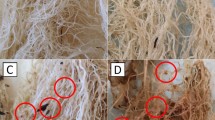Abstract
Marigolds (Tagetes erecta and T. patula) or sea ambrosia (Ambrosia maritima) as intercropped plants with soybean (Glycine max) cv. Giza 21 infected with Meloidogyne incognita, the root-knot nematode, significantly (P≤0.05 and 0.01) reduced nematode numbers on soybean as indicated by the percentage reduction of galls, developmental stages and egg masses in roots and juveniles (J2) in soil. Marigolds significantly (P≤0.05 or 0.01), in most cases, increased plant growth parameters of soybean, but sea ambrosia had an adverse effect on plant growth parameters. Addition of chopped green leaves of sea ambrosia to the soil planted to soybean significantly (P≤0.05 and/or 0.01) reduced M. incognita reproduction and development. Sea ambrosia also had an adverse effect on soybean plant growth.
Similar content being viewed by others
References
Alam MM, Saxena SK, Khan AM (1977) Influence of interculture of marigold and margosa with some vegetable crops on plant growth and nematode population. Acta Bot Indica 5:33–39
Alam MM, Khan AM, Saxena SK (1979) Mechanism of control of plant parasitic nematodes as a result of the application of organic amendments to the soil. V. Role of phenolic compounds. Indian J Nematol 9:146–148
Ameen HH (1996) Effect of garlic, Allium sativum on populations of Rotylenchulus reniformis and Meloidogyne incognita infecting cowpea and tomato. Al-Azhar J Agric Res 23:77–85
Amin AW, Youssef MMA (1997) Efficiency of certain plant leaves for controlling Meloidogyne javanica and Rotylenchulus reniformis infecting sunflower in Egypt. Int J Nematol 7:198–200
Araya M, Caswell-Chen EP (1994) Penetration of Crotolaria juncea, Dolichos lablab and Sesamum indicum roots by Meloidogyne javanica. J Nematol 26:238–240
Dropkin VH (1980) Introduction to plant nematology. Wiley and Sons, New York
El-Gengaihi S E, Osman HA, Youssef MMA, Mohamed SM (2001) Efficacy of Tagetes species extracts on the mortality of the reniform nematode, Rotylenchulus reniformis. Bull NRC, Egypt 26:441–450
Gad-El-Rab SM (2000) Studies on the effect of damsisa dry matter (Ambrosia maritima L.) as natural material to control nematodes of plastic-houses cucumber in Egypt. J Hort 27:373–983
Guenther G (1961) The essential oils. D van Nostrand Comp. Inc., Toronto
Hassan HM (1999) Effect of some biofertilizers and chopped fresh roots of plants on Meloidogyne javanica-infected sugarcane. Egypt J Agronematol 3:163–175
Huang SP (1984) Cropping effects of marigolds, corn and okra on population levels of Meloidogyne javanica and on carrot yields. J Nematol 16:996–998
Korayem AM, Osman HA (1992) Nematicidal potential of the henna plant Lawsonia inermis against the root-knot nematodes Meloidogyne incognita. Anz. Schädlingskde 65:14–16
Mahmood I, Saxena SK (1992) Effect of green manuring with certain legumes on the control of plant parasitic nematodes. Pak J Nematol 10:139–143
Mostafa AM (1997) Ecological and biological studies on nematodes associated with certain medicinal and aromatic plants. PhD Thesis, Al-Azhar University, Cairo
Ploeg AT (1999) Greenhouse studies on the effect of marigolds (Tagetes spp.) on four Meloidogyne species. J Nematol 31:62–69
Sartaj AT, Anver S, Mehar B, Siddiqui MA (1986) Feasibility of growing zinnia as a mix crop along with tomato for control of root-knot and reniform nematodes. Int Nematol Network Newsl 3:6–7
Sayre RM (1980) Promising organisms for biocontrol of nematodes. Plant Dis 64:527–532
Sweelam ME (1989) The potential use of some ornamental plants for nematode control in Egypt. Bull Fac Agric, Cairo Univ 40:391–393
Uhlenbroek JH, Bijloo JD (1958) Investigation on nematodes. I. Isolation and structure of a nematicidal principle occurring in Tagetes roots. Rec Trav Chim Pays Bas Belg 77:1004–1009
Uhlenbroek JH, Bijloo JD (1959) Investigation on nematodes. II. Structure of a second nematicidal principle isolated from Tagetes roots. Rec Trav Chim Pays Bas Belg 78:382–390
Youssef MMA, Soliman MM (1997) Effect of integrated management of Meloidogyne incognta infecting Egyptian herbane, Hyoscyamus muticus and on subsequent cowpea plant. Proc First Conf Agric Sci, Fac Agric Assiut Univ, Assiut, 13–14 December, vol I
Zid AAM (2002) Pathological studies on parasitic nematodes on some economic plants. PhD Thesis, Alexandria University, Egypt.
Author information
Authors and Affiliations
Corresponding author
Rights and permissions
About this article
Cite this article
El-Hamawi, M.H., Youssef, M.M.A. & Zawam, H.S. Management of Meloidogyne incognita, the root-knot nematode, on soybean as affected by marigold and sea ambrosia (damsisa) plants. J Pest Sci 77, 95–98 (2004). https://doi.org/10.1007/s10340-003-0034-1
Received:
Published:
Issue Date:
DOI: https://doi.org/10.1007/s10340-003-0034-1




